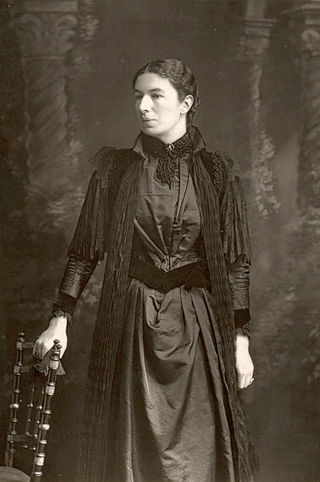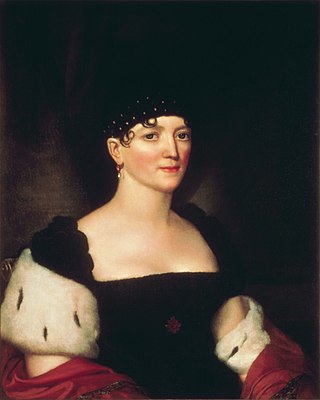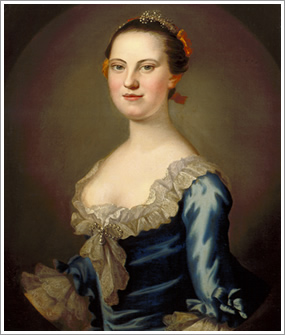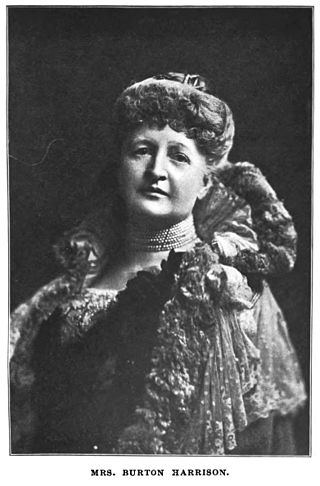
The National Society Daughters of the American Revolution is a lineage-based membership service organization for women who are directly descended from a person involved in supporting the American Revolution. A non-profit group, the organization promotes education and patriotism. Its membership is limited to direct lineal descendants of soldiers or others of the American Revolution era who aided the revolution and its subsequent war. Applicants must be at least 18 years of age and have a birth certificate indicating that their gender is female. DAR has over 190,000 current members in the United States and other countries. The organization's motto is "God, Home, and Country".

Mary Augusta Ward was a British novelist who wrote under her married name as Mrs Humphry Ward. She worked to improve education for the poor setting up a Settlement in London and in 1908 she became the founding President of the Women's National Anti-Suffrage League.

Elizabeth Monroe was the first lady of the United States from 1817 to 1825, as the wife of James Monroe, fifth president of the United States. Due to the fragile condition of Monroe's health, many of her duties as the official White House hostess were assumed by her eldest daughter, Eliza Monroe Hay.

Martha "Patsy" Randolph was the eldest daughter of Thomas Jefferson, the third president of the United States, and his wife, Martha Wayles Skelton Jefferson. She was born at Monticello, near Charlottesville, Virginia.

Mary Foote was an American painter and producer of notes of Carl Jung's seminars. As an artist, she lived and worked in New York's Washington Square, Paris and Peking. From 1928 to the 1950s she lived in Zürich and created and published notes of Carl Jung's seminars until World War II. She returned to the United States in the 1950s and spent her later years in Connecticut, where she died.

Mary Willing Byrd was an American planter. At twenty years of age, she became the step-mother of five children and managed the family and household at Westover Plantation in Charles City County, Virginia beginning her second year of marriage. Together Byrd and her husband, William Byrd III, had ten more children before he committed suicide in 1777. She determined what property to hold on to and what to sell of what she inherited so that she could pay off debts, preserve Westover Plantation, and retain some land for the Byrd children.

Mary Boykin Chesnut was an American writer noted for a book published as her Civil War diary, a "vivid picture of a society in the throes of its life-and-death struggle." She described the war from within her upper-class circles of Southern slaveowner society, but encompassed all classes in her book. She was married to James Chesnut, Jr., a lawyer who served as a United States senator and officer in the Confederate States Army.

Mary Anna Randolph Custis Lee was the wife of the Confederate general Robert E. Lee and the last private owner of Arlington Estate. She was the daughter of George Washington Parke Custis who was the grandson of Martha Washington, the wife of George Washington. Lee was a highly educated woman, who edited and published her father's writings after his death.
Alexander Brown was a Confederate soldier and American merchant, best known as the author of several books on the early history of Virginia.

Constance Cary Harrison, also referred to as Mrs. Burton Harrison, was an American playwright and novelist. She and two of her cousins were known as the "Cary Invincibles"; the three sewed the first examples of the Confederate Battle Flag.
Virginia Randolph Cary was an American writer. She was the author of Letters on Female Character, Addressed to a Young Lady, on the Death of Her Mother (1828), an influential advice book.

Lady Louisa Stuart was a British writer of the 18th and 19th centuries. Her long life spanned nearly ninety-four years.

Mary Stuart Harrison Smith was an American writer, translator, and women's advocate. Her Virginia Cookery Book (1885) is one of the country's early modern cookbooks. In addition to other original works, she published over fifty translated compositions, primarily from the German to English. She was a descendant of the Harrison family of Virginia, and also authored numerous book reviews for various periodicals.

Rosa L. Dixon Bowser was an American educator. She was the first African-American teacher hired in Richmond, Virginia. She organized the Virginia Teachers' Reading Circle, which became the Virginia State Teachers Association, the first organization representing black teachers in Virginia, serving as the organization's president from 1890 to 1892. Bowser was president of the Woman's Christian Temperance Union in Virginia, as well as founder and first president of the Richmond Woman's League. She was a correspondent for the magazine The Woman's Era, and wrote essays for national publications.

Adele Williams was an American artist who was one of the earliest Impressionist painters in Virginia.
Mary Mann Page Newton Stanard was an American historian, specializing in the history of Virginia.

Florence Anderson Clark was an American author, newspaper editor, librarian, and university administrator. She served for 14 years as assistant librarian at the University of Texas (UT), and in honor for her service to the university, she was first woman to have her portrait hung in the university's Main Tower. Clark was affiliated with several organizations, including the Daughters of the American Revolution (D.A.R), Colonial Dames of America, and United Daughters of the Confederacy.

Mary Berkeley Minor Blackford was an American anti-slavery activist, founder of the Female Auxiliary of the American Colonization Society in Fredericksburg.

Dorothea Spotswood Henry was the wife of Patrick Henry. Upon their marriage while he was in office, she served as the first and sixth First Lady of Virginia during Henry's terms as governor, from 1777 to 1779 and 1784 to 1786.
Agnes Sarah Bell Cabell was the First Lady of Virginia from 1805 to 1808 as the wife of the fourteenth governor, William H. Cabell.
















